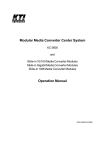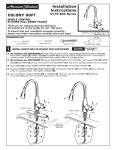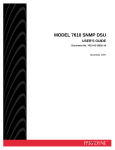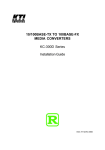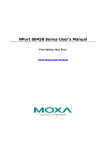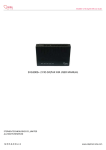Download KTI Networks KC-1300-1A
Transcript
Modular Media Converter Center System KC-1300 Operation Manual DOC.060301-KC1300 -1- (C) 2005 KTI Networks Inc. All rights reserved. No part of this documentation may be reproduced in any form or by any means or used to make any directive work (such as translation or transformation) without permission from KTI Networks Inc. KTI Networks Inc. reserves the right to revise this documentation and to make changes in content from time to time without obligation on the part of KTI Networks Inc. to provide notification of such revision or change. For more information, contact: United States International KTI Networks Inc. P.O. BOX 631008 Houston, Texas 77263-1008 Phone: Fax: E-mail: URL: 713-2663891 713-2663893 [email protected] http://www.ktinet.com/ Fax: E-mail: URL: 886-2-26983873 [email protected] http://www.ktinet.com.tw/ -2- The information contained in this document is subject to change without prior notice. Copyright (C) KTI. All Rights Reserved. TRADEMARKS Ethernet is a registered trademark of Xerox Corp. WARNING: This equipment has been tested and found to comply with the limits for a Class A digital device, pursuant to Part 15 of the FCC Rules. These limits are designed to provide reasonable protection against harmful interference when the equipment is operated in a commercial environment. This equipment generates, uses, and can radiate radio frequency energy and if not installed and used in accordance with the instruction manual may cause harmful interference in which case the user will be required to correct the interference at his own expense. NOTICE: (1) The changes or modifications not expressively approved by the party responsible for compliance could void the user's authority to operate the equipment. (2) Shielded interface cables and AC power cord, if any, must be used in order to comply with the emission limits. CISPR A COMPLIANCE: This device complies with EMC directive of the European Community and meets or exceeds the following technical standard. EN 55022 - Limits and Methods of Measurement of Radio Interference Characteristics of Information Technology Equipment. This device complies with CISPR Class A. WARNING: This is a Class A product. In a domestic environment this product may cause radio interference in which case the user may be required to take adequate measures. CE NOTICE Marking by the symbol indicates compliance of this equipment to the EMC directive of the European Community. Such marking is indicative that this equipment meets or exceeds the following technical standards: EN 55022: Limits and Methods of Measurement of Radio Interference characteristics of Information Technology Equipment. EN 50082/1:Generic Immunity Standard -Part 1: Domestic Commercial and Light Industry. EN 60555-2: Disturbances in supply systems caused by household appliances and similar electrical equipment - Part 2: Harmonics. -3- Table of Contents 1. Introduction ......................................................... 6 1.1 Features ........................................................................................ 7 1.2 Technical Specifications ............................................................... 8 2. Installation ......................................................... 12 2.1 Unpacking .................................................................................... 2.2 System Units ............................................................................... 2.2.2 Management Module ................................................................ 2.2.3 Power Chassis Modules .......................................................... 2.3 Rack Mounting ............................................................................. 12 12 14 16 22 3. Network Management ....................................... 23 3.1 3.2 3.3 3.4 Management Functions ............................................................... Protocols Supported ................................................................... Setup for Out-of-band (Console) Management ........................... Setup for In-band Management ................................................... 23 24 25 27 4. Console and Telnet Operation ......................... 28 4.1 IP Menu ........................................................................................ 4.2 SNMP Menu ................................................................................. 4.3 View System Status ..................................................................... 4.4 View Converter Slots Status ........................................................ 4.5 Restore Default Values ................................................................ 4.6 Security Manager ......................................................................... 4.7 Update Firmware ......................................................................... 4.8 Reboot System ............................................................................ 32 33 34 35 37 38 39 40 5. SNMP Management .......................................... 41 5.1 Configuring SNMP Settings via Console Operation ................... 42 5.2 SNMP Private MIB ........................................................................ 43 5.3 SNMP Traps ................................................................................. 44 6. Web Management ............................................. 45 6.1 Start Browser Software and Making Connection ......................... 6.2 Login to the System Unit ............................................................. 6.3 Converter Status .......................................................................... 6.4 System Status ............................................................................. 6.5 Administrator Menu ...................................................................... -4- 45 46 48 50 51 6.5.1 Basic ......................................................................................... 6.5.2 Console Port Information ......................................................... 6.5.3 Security Manager ...................................................................... 6.5.4 Image Refresh Time ................................................................ 6.5.5 Update Firmware ...................................................................... 6.5.6 Reboot System ......................................................................... 6.6 Slot Icon Operations .................................................................... -5- 52 57 58 59 60 61 62 1. Introduction The Modular Converter System KC-1300 is a managed media converter rack that provides 16 slots and hosts 16 units of Media Converter (MC). A wide range of media converters are available depending on your variety of network cabling environment. These optional media converters include Gigabit and Fast Ethernet copper to multimode or single mode fiber cable. The rack unit provides a centered power supply to the converter modules and serves as a converter center and wiring concentrator. For specifications of media converter KC-300D, KC-300DM, KGC-300 and KGC-310, refer to the associated installation guides respectively. -6- 1.1 Features Some of the key features include: • Managed Media Converter Center Rack • 19-inch rack-mountable 2U chassis • Managed system accommodates up to 16 media converters • Highly modularized chassis design with - modular media converters - modular management module - two system power modules for power redundancy • Provides high availability and maintainability • Power backup feature with two power chassis • Visible system status indication • Supports in-band Telnet, SNMP and web-based management • Supports out-of-band direct console management • Management from anywhere and any platform using a web browser • Easy-to-use point and click user interface • Photographic quality interface to configure and monitor the system • Supports in-band event SNMP trap report • Photographic quality interface to configure and monitor the system • TFTP Software Upgrade -7- 1.2 Technical Specifications System Model Management support Plug-in power modules Input voltage Power supply rating Weight (no MC installed) System Model Management support Plug-in power modules Input voltage Power supply rating Weight (no MC installed) KC-1300L/1A KC-1300L/2A KC-1300/1A KC-1300/2A Unmanaged 1 AC 90~264V 60W 5.5Kg KC-1300L/1D Managed 1 AC 90~264V 60W 5.5Kg Managed 2 AC 90~264V 60W 6.2Kg KC-1300L/2D KC-1300/1D KC-1300/2D Unmanaged 1 DC -48VDC 60W 5.5Kg Common Specifications 19-inch rack mount Number of MC slots Number of power slots Cooling Dimension Environmental Operating temperature Storage temperature Operating humidity Emission standard Conducted emission Radiated emission Voltage harmonics Voltage fluctuation & flicker Susceptibility Electrostatic discharge immunity Radiated immunity EFT/Burst immunity Surge immunity Continuous wave voltage immunity PFMF immunity Voltage DIP/Interrupt immunity Certifications FCC CE Unmanaged 2 AC 90~264V 60W 6.2Kg Unmanaged 2 DC -48VDC 60W 6.2Kg Managed 1 DC -48VDC 60W 5.5Kg Managed 2 DC -48VDC 60W 6.2Kg Yes 16 slots 2 1 DC Fan H 88mm (2U) x W 443mm x D 328mm -5~40o C -20~75 o C 10~90%RH EN55022, CISPR 22 EN55022, CISPR 22 EN61000-3-2 EN61000-3-3 EN61000-4-2, IEC61000-4-2 EN61000-4-3, IEC61000-4-3 EN61000-4-4, IEC61000-4-4 EN61000-4-5, IEC61000-4-5 EN61000-4-6, IEC61000-4-6 EN61000-4-8, IEC61000-4-8 EN61000-4-11, IEC61000-4-11 Part 15, Class A EMC Class A, EN50081-1,EN50082-1 -8- AC Power Chassis Module Specifications Dimension 194mm x 156.6mm x 40.3mm Installation method Plug in from system rear panel Maintenance Modular design for easy maintenance AC power switch System power on/off switch AC power receptacle IEC320 type receptacle Power status indicator Green LED Electric Input voltage rating 100 ~ 240VAC Input voltage range 90 ~ 264VAC Input frequency 47 ~ 63Hz Input surge current 20A max. @115VAC Efficiency 75% @115VAC full load Output power 60W Over current protection All output with short circuit protection Safety UL/cUL, TUV EN60950 Insulation Resistance >10M Ohm @DC500V Dielectric withstands 1500VAC 10mA 1min. DC Power Chassis Module Specifications Dimension 194mm x 156.6mm x 40.3mm Installation method Plug in from system rear panel Maintenance Modular design for easy maintenance DC power switch System power on/off switch DC power receptacle Screw type terminal block Power status indicator Green LED Electric Input voltage rating -48VDC Input voltage range -48VDC +/-10% Efficiency 73% typ. at full load Output power 60W Protection Over voltage, over power, short circuit Safety Meet UL1950 -9- Management Module Specifications Dimension 107mm x 24mm x 86.4mm Slot position Slot 0 CPU RISC-based ARM7 RAM size 2M bytes Flash size 512K bytes System interface Connector FutureBus Console interface Interface RS-232 DTE Connector 9-pin male D-SUB connector Baud rate 38400, N, 8, 1, 0 Flow control Disabled In-band interface Interface 10/100M LAN port Connector Shielded RJ-45 MDI Standard IEEE 802.3 10BASE-T/100BASE-TX Auto-negotiation Support LED Indicators P1, P2 Green LED, power module status DIAG Green LED, CPU initialization FAN Green LED, Fan failure indication CONSOLE Green LED, Console RS-232 Rx activities LNK/ACT. Green LED, LAN port link and activities status -10- Management Specifications Management interface Telnet Via direct RS-232 console connection Telnet Via TCP/IP Telnet software SNMP agent Via TCP/IP SNMP manager software HTTP server Via web browser software Protocols IPv4 IP version4 RFC791 TCP Transmission Control Protocol RFC793 UDP User Datagram Protocol RFC768 ICMP Internet Control Message Protocol RFC792 SNMP SNMP agent v1 RFC1157 MIB-II Standard MIB RFC1213 TFTP Trivial File Transfer Protocol RFC1350 TELNET Telnet protocol RFC854 HTTP HTTP server for web management RFC1945 Management Objects Password for access control Set and monitor System status : CPU, memory, flash, software Monitor System power 1&2 status Monitor System fan status Monitor IP address of the system Set and monitor Subnet mask of the system Set and monitor Default gateway IP address Set and monitor SNMP name information Set and monitor SNMP location information Set and monitor SNMP contact information Set and monitor SNMP community names (up to 4) Set and monitor SNMP community access right (up to 4) Set and monitor SNMP trap host IP address (up to 3) Set and monitor Slot status : MC installed or not Monitor MC status : media type, speed, duplex Monitor MC link status of two ports Monitor Remote MC link status (two KC-300DMs link only) Monitor SNMP Traps Cold Start System is powered on and completes initialization Authentication failure SNMP community authentication failure Power status The system power 1&2 failure and recovery Fan failure System fan failure and recovery Slot # Port A link Slot # MC Port A link down or up Slot # Port B link Slot # MC Port B link down or up Slot # RTP link Slot # Remote MC TP port link change Update Firmware Via TFTP protocol Remote boot system -11- 2. Installation 2.1 Unpacking The product package contains: • The system unit • One power cord • One 19-inch rack mounting kit • Operation Manual 2.2 System Units The figure below illustrates the front view of the KC-1300 system: Depending on the model purchased, the type and numbers of the preinstalled media converters may be different. The figure shows a system which is fully installed with media converters. The following figures show the rear view of the KC-1300 system. The main chassis provides two power chassis slots on the rear panel. Each power chassis slot can be installed with one AC power chassis. Two power slots design features the system a power redundant function. -12- The following figure shows the model equipped with two AC power chassis. Main Chassis : provides insertion slots on front panel for CPU management module and optional add-on media converters. It also provides two chassis slots on rear for mounting power chassis modules. Management Module : serves as a management agent to monitor system status and add-on converter modules for in-band and out-of-band management requests. Power Chassis : provides full centered power supply for whole system unit. It can receive commercial AC power with AC power chassis and 48VDC power with DC power chassis. System Cooling Fan : provides forced air to cool down the temperature for the system unit. -13- 2.2.2 Management Module The system unit comes with one pre-installed Management module. The module facilitates the following functions: • Direct out-of-band management via RS-232 console port • SNMP agent to serve in-band management via SNMP protocol • Telnet console in-band management via TCP/IP protocol • HTTP host to serve web-based in-band management • Monitoring all MCs status installed in the system • Monitoring system power and fan status See figure below for major components on the panel: -14- Console Port This port is a 9-pin male D-sub connector. It serves as an RS-232 DTE port. Refer to Chapter xx for the console operation. The pin definitions are: Pin2 Pin 3 Pin 4 Pin 5 Pin 6 RXD TXD DTR GND DSR UTP Port This is an auto-negotiation 10/100BASE-TX LAN port and provides a shielded RJ-45 jack with MDI definition. This port must connect to your TCP/IP network for all in-band management operations. LED Indicators P1 P2 DIAG Color Green Green Green FAN Green CONSOLE LNK/ACT Green Green Green States On On On Off On Off On On Blink Interpretation Power 1 module is ON Power 2 module is ON CPU initialization Initialization complete Fan failure detected Fan in normal operation Rx activities of console port LAN port link is active Tx/Rx activities of UTP port -15- 2.2.3 Power Chassis Modules The system power supply is assembled in a plug-in chassis module as shown below: Each single power module is capable to supply full power for system operation with media converters fully installed. AC Power Chassis Specifications (KC1300-AC) AC power switch System power on/off switch AC power receptacle IEC320 type receptacle Input voltage range 90 ~ 264VAC Input frequency 47 ~ 63Hz Output power 60W AC power cord IEC320 type power cord Power status display Green LED -16- DC Power Chassis Specifications (KC1300-DC) Input power switch System power on/off switch Input power receptacle Terminal connector (screw type) Input voltage rating -48VDC Input voltage range -48VDC +/-10% Output power 60W Power status display Green LED -17- Removal of System Power Chassis The system power chassis is pre-installed in the system unit when system unit is shipped from factory. The chassis is designed for easy uninstallation from system unit in case of any inspection purpose. However, note that this removal only can be performed by a well-trained technical person. For safety reason before removing the power chassis, make sure: • The power switch is turned off. • The power cord is disconnected from the power chassis. To remove the chassis, unscrew two chassis screws until they are released from system chassis, hold the handle and pull the chassis out from the system chassis smoothly. See the following example figure: -18- Insertion of System Power Chassis Before inserting the power chassis into system unit, make sure: • The system power switch is turned off. • The power cord is disconnected from the power chassis. To insert the power chassis, hold the handle and push it into system unit until it is seated in system chassis properly. Screw the chassis securely in the system unit. See figure below: The power chassis is designed to be hot plugged into or unplugged from the system even when another power chassis is installed in another power slot and in operation. -19- 2.2.4 Media Converter Slots The system chassis provides sixteen slots for installing optional slide-in MCs. A media converter can be inserted into an available slot or removed from a slot anytime even when system unit is powered on. This hot-plug design keeps all exiting connections on the other slots running with no influence. To insert an MC into a slot, the steps are: 1. Install a bracket, which is provided in the rack chassis package onto the MC unit as shown below: 2. Remove slot cover first and insert the MC into slot slowly until it is seated in slot properly. 3. Screw the bracket onto system chassis securely before making any cable connection. -20- To remove an MC from slot, the steps are: 1. Disconnect all cable connections on the MC first. 2. Unscrew the MC bracket from system chassis. 3. Hold the bracket and pull it slowly out from the slot. The media converters are designed with hot-plug feature, which allows insertion and removal of the converters can be performed even when the system is in operation. -21- 2.3 Rack Mounting One rack mounting kit is supplied in the product package. It includes two rack mounting brackets and screws for installing the system unit into a 19-inch rack. Mount both brackets onto the system unit as shown below: Install the system unit into a 19-inch rack as shown below: -22- 3. Network Management 3.1 Management Functions The managed converter rack system series is featured with management functions and can be managed by using the following methods: • • • • Direct console connection over an RS-232 cable Telnet software over TCP/IP network SNMP manager software over TCP/IP network Web browser software from Internet or Intranet over TCP/IP network Management Interface Console operation Console operation SNMP management Web browser RS-232 / Protocol RS-232 console port Telnet over TCP/IP SNMP over TCP/IP HTTP over TCP/IP The following figure illustrates a management model diagram: -23- The system unit is equipped with one management module which serves as a management agent to monitor the system status and all installed media converter modules. The agent also responses to either in-band management requests coming from network or out-of-band requests from directly connected console. 3.2 Protocols Supported Protocols IPv4 TCP UDP ICMP SNMP MIB-II TFTP TELNET HTTP Name IP version4 Transmission Control Protocol User Datagram Protocol Internet Control Message Protocol SNMP agent v1 Standard MIB Trivial File Transfer Protocol Telnet protocol HTTP server for web management -24- Reference RFC791 RFC793 RFC768 RFC792 RFC1157 RFC1213 RFC1350 RFC854 RFC1945 3.3 Setup for Out-of-band (Console) Management Before doing any in-band management, it is necessary to perform console operation for configuring IP and SNMP related settings for the first time the system is received for installation. The console port is located on the SNMP module. Any PC running Windows can be used as a console via COM port. Windows Hyper Terminal program is an ideal and the most popular software for such console terminal operations. To setup console operation, the steps are: 1. Find a proper RS-232 cable for the connection to a console terminal. If your are using PC as a terminal, make sure the cable pin assignments comply to the following requirement. Console port 9-pin PC COM port Pin2 RXD -------------------------------3 3 TXD -------------------------------2 4 DTR -------------------------------6 5 GND -------------------------------5 6 DSR -------------------------------4 -25- 2. Connect one end to the console port and connect the other end to the PC COM port. 3. Configure your PC COM port setting to match the RS-232 settings of the console port and start your terminal software. Factory default settings of the Console port Baud rate : 38400, N, 8, 1, 0 Flow control : disabled 4. Turn the system power on. 5. Press <Enter> key several times in your terminal software until a login prompt comes up. It means the connection is proper. The console port does not support modem connection. Refer to Chapter 4 for more information about Console management. -26- 3.4 Setup for In-band Management To perform an in-band management, it is necessary to connect the system to your TCP/IP network. The steps are: 1. Configure IP and SNMP related settings to the system using direct console management when you receive it first time for the installation. 2. Find a proper straight-through Category 5 UTP cable (maximal length 100 meters) for the connection. 3. Connect one end of the UTP cable to the UTP port on SNMP module and connect the other end to the device, such as a switching hub, in your TCP/IP network. 4. Start your in-band management operations. For different management methods, refer to: • Chapter 4 for Telnet management • Chapter 5 for SNMP management • Chapter 6 for Web management -27- 4. Console and Telnet Operation Functions supported: • Set and display IP parameters for the system. • Set and display SNMP parameters for the SNMP agent function. • Monitor system power status, power temperature status, system fan status and other system information. • Monitor installation status of each slots. • Monitor the configuration and link status of each MC installed. • Restore default settings for the system • Change administrator password for access control. • Update system software. • Reboot (warm start) the system remotely. Management Objects Modify Password for access control Y System : CPU, memory, flash, software version Power 1&2 status System fan status IP address of the system Y Subnet mask of the system Y Default gateway IP address Y SNMP name Y SNMP location Y SNMP contact Y SNMP community name (up to 4) Y SNMP community access right (up to 4) Y SNMP trap host IP address (up to 3) Y Slot status : module installed or not MC status : media type, speed, duplex MC link status of two ports Remote MC TP link status * - -28- Monitor Y Y Y Y Y Y Y Y Y Y Y Y Y Y Y Y * Remote MC TP link status monitoring is available only when KC300DM in the rack is connected to a remote KC-300DM through fiber link. Cold Start When the power to the system is turned on, the system start initialization and self-test process. The self-test messages are displayed as follows if a console connection is established successfully.: Power-on Self-test --------------------------------------------$$$ System LOADER Checksum O.K !!! $$$ System IMAGE Checksum O.K !!! $$$ System DATA Checksum O.K !!! $$ Waiting Copy Rom to Sdram $$$ System Power On Self Test.... $$$ ARM Reg R/W Test Success !!! $$$ System EEPROM Checksum O.K !! $$$ Get parameter O.K !! My Mac Address is xxxxxxxxxxxx --------------------------------------------- This chapter describes the detailed console operation. It can be applied to either out-of-band console management or in-band Telnet management. Both are same in operation starting from login prompt. -29- Direct Console Management When you can see the self-test messages shown on screen properly, you can press <Enter> key to start console login operation. Go to Login Prompt section in next page directly. Telnet Management Use Telnet software to perform the management operation. The most convenient solution is using the built-in Telnet function in a Windows 95/98/ or NT PC. Enter into DOS window and invoke Telnet command : >telnet xxx.xxx.xxx.xxx to connect to the system unit. The specified xxx.xxx.xxx.xxx is the IP address of the system unit. A welcome message and login prompt are displayed if the connection is established properly. Login Prompt The following figure illustrates the login screen: --------------------------------------------Welcome to Console login:admin password:*** --------------------------------------------- Username : admin Factory default Password : 123 For security reason, the system supports a function to change the password in setup menu. It is recommended to change the default password immediately after a successful login. -30- When login successfully, a Setup menu is shown as follows: --------------------------------------------Setup Menu TCP/IP stack for KC-1300 V1.xx [0] Print this menu [1] IP Menu [2] SNMP Menu [3] View System status [4] View Converter Slots Status [5] Restore Default Value [6] Security Manager [7] Update Firmware [8] Reboot System [9] Exit Please Select (0-9 ).... Enter Esc to abort.... INET> --------------------------------------------- After prompt, type a number followed by [Enter] key for selecting an operation item to perform. See example below: INET> n <Enter> Select [0] to display main menu again. [Esc] key can be used to abort the operation of any item and back to main menu. The following sections describe the detailed operation of each item. -31- 4.1 IP Menu Select [1] from Setup menu to set IP related settings. --------------------------------------------IP Menu [0] Print this menu [1] Set IP Address [2] View IP Status [3] Exit Please Select (0-3) --------------------------------------------- Set IP Address ---------------------------------------------------------------------Enter ESC to abort. Please Input IP Address(xxx.xxx.xxx.xxx):192.168.0.23 replacing net[0] IP address nnn.nnn.nnn.nnn with 192.168.0.23 Please Input Subnet Mask(xxx.xxx.xxx.xxx):255.255.255.0 replacing subnet mask[0] IP address nnn.nnn.nnn.nnn with 255.255.255.0 Please Input Gateway IP(xxx.xxx.xxx.xxx):192.168.0.1 replacing gateway IP addr[0] nnn.nnn.nnn.nnn with 192.168.0.1 Do you want to Change IP setting ? (Y/N)Y Please reboot system and use new IP to connection it ! ----------------------------------------------------------------------- IP Address : Unique IP address designated to this system Subnet Mask : The subnet mask of the IP address specified above Gateway : The IP address of the default gateway (router) Note that all current in-band network management connections on the system will be killed if system IP address is changed. This change does not affect the operation of the media converter modules in slots. View IP Status ----------------------------------------------IP Addr: 192.168.0.23 Submask: 255.255.255.0 Gateway: 192.168.0.1 -----------------------------------------------32- 4.2 SNMP Menu Select [2] from Setup menu to perform SNMP related settings. The following figure illustrates the SNMP menu: --------------------------------------------Snmp Menu [0] Print this menu [1] View Snmp Setting [2] Set Snmp Name [3] Set Snmp Location [4] Set Snmp Contact [5] Set Snmp Community [6] Set Snmp Trap Manager [7] Exit Please Select (0-7 ).... INET> --------------------------------------------- SNMP related settings are: Name Location Contact Community : Logic name for the system (127 characters) : Location where the system is installed (127 characters) : Contact person regarding the system (127 characters) : SNMP communities to which the system belongs and access right to the system ( R : read only, W : read/write) Maximum of four communities are supported. Trap manager: IP address of the trap host to which a trap is issued and the trap community to which the system belongs. Maximum of three trap hosts are supported. [Esc] key can be used to abort unfinished setting. -33- 4.3 View System Status Select [3] from Setup menu to view system status. The system status are shown as follows: --------------------------------------------Power 1 Status: Good , Power 2 Status: Good FAN status: Good CPU status: Cpu Type = ARM7, Flash Size = 512K, Sdram Size = 2M Bytes Software version 1.xx --------------------------------------------- Power status indicates the status of system power 1&2 chassis. Power Status : Good, Bad FAN status indicates the status of system cooling fan. FAN Status : Good, Bad CPU information and software version are static information for reference. -34- 4.4 View Converter Slots Status Select [4] from setup menu to view current status of all media converter modules in the system. The slot status are shown as follows: ----------------------------------------------------------------------Slot Port Media Speed Duplex Link Slot Port Media Speed Duplex Link RTP 01 A TX 100M Full Up 01 B FX 100M Full Up UP 02 A TX 100M Full Up 02 B FX 100M Full Up UP 03 A TX 100M Full Up 03 B FX 100M Full Up UP 04 A TX 100M Full Up 04 B FX 100M Full Up UP 05 A TX 100M Full Up 05 B FX 100M Full Up UP 06 A TX 100M Full Up 06 B FX 100M Full Up N/A 07 A TX 100M Full Up 07 B FX 100M Full Up N/A 08 A TX 100M Full Up 08 B FX 100M Full Up N/A 09 A TX 100M Full Up 09 B FX 100M Full Up N/A 10 A TX 100M Full Up 10 B FX 100M Full Up N/A 11 A TX 100M Full Up 11 B FX 100M Full Up N/A 12 A TX 100M Full Up 12 B FX 100M Full Up - 13 A TX 100M Full Up 13 B FX 100M Full Up - 14 A TX 100M Full Up 14 B FX 100M Full Up - 15 A TX 100M Full Up 15 B FX 100M Full Up - 16 A TX 100M Full Up 16 B FX 100M Full Up - ----------------------------------------------------------------------- -35- The slot status definitions are: Column Slot States 01-16 Interpretation Slot position in the system Slot #1 - slot #16 are for MC Port N/A A B No module is installed in slot Upper port of the module in slot Lower port of the module in slot Media N/A TX T FX X No MC is installed in slot. 10BASE-T, 10/100BASE-TX port type 1000BASE-T port type 100BASE-FX port type 1000BASE-X port type Speed N/A 10M 100M 1000M No MC is installed in slot 10Mbps 100Mbps 1000Mbps Duplex N/A Full Half No MC is installed in slot. Full duplex Half duplex Link N/A Up Down No MC is installed in slot. Link up Link down RTP * N/A Up - Status not available Remote MC TP link up MC in slot does not support RTP * RTP : Remote MC TP link status monitoring is available only when both the MC in the rack and the remote link partner support the function through fiber link. -36- 4.5 Restore Default Values Select [5] from Setup menu to restore factory default settings. Factory default settings are: IP Address 192.168.0.2 Subnet Mask 255.255.255.0 Default Gateway 192.168.0.1 User Name admin Password 123 Name (null) Location (null) Contact (null) SNMP Communities: No.1 Community name public No.1 Access right Read only No.2 Community name (null) No.2 Access right (N/A) No.3 Community name (null) No.3 Access right (N/A) No.4 Community name (null) No.4 Access right (N/A) SNMP Trap Managers: No.1 Trap manager IP (null) No.1 Community name (null) No.2 Trap manager IP (null) No.2 Community name (null) No.3 Trap manager IP (null) No.3 Community name (null) -37- 4.6 Security Manager Select [6] from Setup menu to change login user name and password. The steps are: Display current user name --------------------------------------------Current username: admin Current password: ******** Press Esc to abort .... --------------------------------------------- Change user name and password --------------------------------------------Change username [admin]: xxxxxx Enter password(1-8): ******** Confirm password: ******** Password updating ....... Password updated. INET> --------------------------------------------- -38- 4.7 Update Firmware Select [7] from Setup menu to perform firmware (system software) upgrade via TFTP protocol. Before doing TFTP operation, one TFTP server is required and installed in the network to where this system connects and new firmware file image.bin must be placed in the TFTP server. The following information are required for TFTP operations: TFTP Server IP Address: IP address of the TFTP server where the firmware image.bin is downloaded from. -39- The steps are: Specify TFTP server IP address --------------------------------------------Enter ESC to abort. Please Input TFTP Server IP Address (xxx.xxx.xxx.xxx):192.168.0.88 TFTP Server: 192.168.0.88 --------------------------------------------- Confirm to start downloading --------------------------------------------Do you want to start download new image ? (Y/N) Y Download image and please wait........ --------------------------------------------- Confirm to update system flash memory --------------------------------------------Download new image complete, do you want to update flash ? (Y/N) Y Update flash and please wait .... Update flash complete and please reboot system ! INET> --------------------------------------------- 4.8 Reboot System Select [8] from Setup menu to reboot the system. This reboot function allows you to perform a warm start to the system. --------------------------------------------Do you want to reboot system ? (Y/N) Y --------------------------------------------- -40- 5. SNMP Management SNMP management are performed at a network management station running SNMP network management application manager software with graphical user interface. The following figure illustrates an example model: The system unit serves as an SNMP agent and provides the capabilities that allows network administrators via SNMP protocol to set parameters and view system status and media converter status defined in the standard MIB-II and private MIB. -41- 5.1 Configuring SNMP Settings via Console Operation Before performing SNMP operation, proper SNMP settings must be configured in the system unit. The SNMP related settings are: Name : Logic name to identify a specific system unit Location : Location where the system is installed Contact : Contact person regarding the system Community : SNMP communities to which the system belongs and access right to the system ( read only or read/write) Trap hosts : IP addresses of trap hosts to which a trap is issued and the trap community to which the system belongs. Up to four SNMP communities and up to three trap hosts are supported by the system SNMP agent. These settings can be configured through console or telnet operation. Refer to Chapter 4 for more information. -42- 5.2 SNMP Private MIB Use the SNMP management application software to compile the MIB file first before performing any management operation. In addition to standard MIB-II (RFC1213), the system supports private MIB as below: Private MIB Objects ssPowerStatus(kti.30.1.1) ssFanStatus(kti.30.1.2) cputype(kti.30.2.1) flashrom(kti.30.2.2) memsize(kti.30.2.3) softwarever(kti.30.2.4) mibFileVer(kti.30.2.5) portNumber(kti.30.3.1) portTable(kti.30.3.2) portEntry(1) slotIndex(1) slotIndexDescription(2) slotModuleDescription(3) slotModuleType(4) sotModuleStatus_PortA_Media(5) slotModuleStatus_PortA_LineSpeed(6) slotModuleStatus_PortA_Duplex(7) slotModuleStatus_PortA_LinkStatus(8) slotModuleStatus_PortB_Media(9) slotModuleStatus_PortB_LineSpeed(10) slotModuleStatus_PortB_Duplex(11) slotModuleStatus_PortB_LinkStatus(12) slotModuleStatus_RTP_LinkStatus(13) * Get Y Y Y Y Y Y Y Y Y Y Y Y Y Y Y Y Y Y Y Y Y Remark Power 1&2 status System fan status ARM7 512KB 2MB 1.xx 1.xx Total number of slots Slot ID 1 - 16 Slot1 - Slot16 Port A media type Port A line Speed Port A duplex mode Port A Link status Port B media type Port B line speed Port B duplex mode Port B link status Remote MC link status Note: Port A : the upper port of the MC, Port B : the lower port of the MC Refer to MIB file, KC1300-Vx.xx.mib for the details. This file can be used for MIB compiler. -43- 5.3 SNMP Traps The system also supports the following SNMP traps. When the trap event occurs, the SNMP agent will generate a trap notification to SNMP management station. Trap Name Cold Start Authentication failure Power status Power status Fan status Fan status Slot # Port A link Slot # Port A link Slot # Port B link Slot # Port B link Slot # RTP link Event of Trap Generated The system is powered on and complete initialization SNMP community authentication failure Any power failure of Power1and Power2 Any power recovery of Power1 and Power2 Fan failure Fan recovery Slot # MC Port A link down or up Slot # MC Port A link recovery Slot # MC Port B link down or up Slot # MC Port B link recovery Slot # remote MC TP link change The binding information together with a trap is : Trap Name Cold Start Authentication failure Power Status Fan Status Slot # Port A link Slot # Port B link Slot # RTP link VarBind sysDescr, ie KC-1300 sysDescr, ie, KC-1300 Power status for Power1 and Power2 Fan status Slot description and Port A link status Slot description and Port B link status Slot description and remote MC TP link status Remark: 1. The slot # can be slot 1 up to slot 16. 2. Port A : the upper port of the MC installed in slot. 3. Port B : the lower port of the MC installed in slot. -44- 6. Web Management The system features an http server which can serve the management requests coming from any web browser software over internet or intranet network. Web Browser Compatible web browser software with JAVA support Microsoft Internet Explorer 4.0 or later Netscape Communicator 4.x or later Set IP Address for the System Unit Before the system can be managed from a web browser software, make sure a unique IP address is configured to the system. Refer to Chapter 4 for how to set IP address. 6.1 Start Browser Software and Making Connection Start your browser software and enter the IP address of the system unit to which you want to connect. The IP address is used as URL for the browser software to search the device. URL : http://xxx.xxx.xxx.xxx/ Factory default IP address : 192.168.0.2 -45- 6.2 Login to the System Unit When browser software connects to the system unit successfully, a Login screen is provided for you to login to the device as follows: Login Username : Admin Factory default Password : 123 -46- The following screen shows welcome screen when a successful login is performed. In addition to the device image, the screen supports the following functions on the right side: 1. 2. 3. 4. Home : home page and device image Converter Status : view all slot status System Status : view system related status Administrator : other management functions -47- 6.3 Converter Status Click [Converter Status] to view all slot status in a table list. -48- The information includes: Column Slot States 1-16 Interpretation Slot position in the system Slot #1 - slot #16 are for MC installation Port A B Upper port of the MC in slot Lower port of the MC in slot Media TX T FX X 10/100BASE-TX copper port type 1000BASE-T copper port type 100BASE-FX Optic fiber port type 1000BASE-X Optic fiber port type Link Green Red Link up Link down Speed 10Mbps 10BASE-T 100Mbps 100BASE-TX or 100BASE-FX 1000Mbps 1000BASE-T or 1000BASE-SX/LX Duplex Full Half RTP link Green Red Full duplex Half duplex Remote MC TP link up Remote MC TP link status not available -49- 6.4 System Status Click [System Status] to view system related status in a table list. The information includes: Power Status FAN Status CPU type RAM size Flash size Software version : system power 1&2 chassis condition : system fan status : CPU model equipped in management module : Memory size equipped in management module : Flash memory equipped in management module : Software version built in management module -50- 6.5 Administrator Menu Click [Administrator] to show administrator menu. The menu includes the following options: 1. Basic : Set / View IP and SNMP related settings 2. Console Port Information : View RS-232 console configuration 3. Security Manager : Change login user name and password 4. Image Refresh Time : Set refresh time interval of the image 5. Update Firmware : Update the software built in SNMP module 6. Reboot System : Reboot the system remotely Refer to the following sections for the details. -51- 6.5.1 Basic Click [Basic] to perform IP setting and SNMP settings. IP setting and SNMP setting are described in the following sections respectively. -52- Click [IP Address] button to set IP settings. IP settings include: IP Address Subnet Mask Gateway : Unique IP address designated to this system : The subnet mask of the IP address specified above : The IP address of the default gateway (router) Click [Update Settings] to make new settings effective. However, a new IP address change will make your current connection invalid. Restart your web link with new IP address to connect the system. -53- Click [SNMP Entries] button to set SNMP settings. SNMP Entries - System options SNMP related settings are: Name Location Contact [Apply] : Logic name for the system : Location where the system is installed : Contact person regarding the system : Click button to make the settings effective -54- SNMP Entries - Community Strings One community contains two settings: Community name : SNMP communities to which the system belongs Access right : Access right associated with the community name Click [Add] button to add one new community into the community list. Click [Remove] button to remove one community from the community list. Up to four entries are supported in the community list. -55- SNMP Entries - Trap Managers One Trap Manager contains two settings: IP Address : IP address of the trap host to which a trap is issued Community : The trap community to which the system belongs Enable Fan Trap: Enable trap for Fan failure events Enable Power Trap: Enable trap for power failure events Enable Link Change Trap: Enable trap for any link change events Click [Add] to add one trap manager into the manager list. Click [Remove] to remove one trap manager from the manager list. -56- 6.5.2 Console Port Information This screen displays configuration of RS-232 console port. -57- 6.5.3 Security Manager Security Manager allows you to change login user name and password. Click [Apply] to make the changes effective. -58- 6.5.4 Image Refresh Time The system image is updated periodically to present the latest status. The default time interval of refreshing the image is 20 seconds. It can be changed by clicking any of the time buttons displayed. This is a run time setting and not a permanent setting. -59- 6.5.5 Update Firmware [Update Firmware] allows you to perform firmware (system software) upgrade via TFTP protocol. Before doing TFTP operation, one TFTP server is required and installed in the network to where this system connects and new firmware file image.bin must be placed in the TFTP server. Set IP address for the TFTP server from where the firmware image is to be downloaded. Specify the file name as Image.bin. Click [Apply] to start the file transfer operation. -60- 6.5.6 Reboot System [Reboot System] allows you to reboot the system unit remotely. Starting this command will make your current http connection lost. You must rebuild the connection to perform any management operation to the unit. -61- 6.6 Slot Icon Operations In addition to the menu supported, you may click the following image icons to show specific status. Click slot 0 on the system image shown on screen Power Status Fan Status CPU type RAM size Flash size Software version : system power 1&2 condition : system fan status : CPU model equipped in management module : Memory size equipped in management module : Flash memory equipped in management module : Software version built in management module -62- Click any one slot in slot 1 to slot 18 to view one specific slot status. The following figure illustrates slot 9 status: Refer to section 6.3 for status interpretation. -63-































































